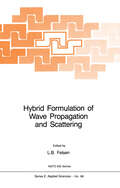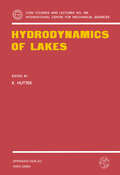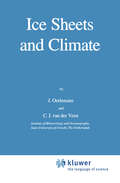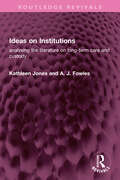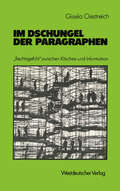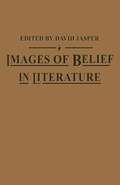- Table View
- List View
Human Motor Actions: Bernstein Reassessed (ISSN #Volume 17)
by H. T. A. WhitingUnder the title The Coordination and Regulation of Movements, an English language version of six of the most important papers of the Russian physiologist Nicholas Bernstein was published in 1967 (Pergamon Press Ltd.). That work has been out of print for some years, but in view of the frequency of its citation in recent works on movement control, a republication was considered desirable. However, since some of the papers in the first edition were written in the 1930's, it was felt that readers' interests would be better served if, after each chapter, an evaluation of the work and, where necessary, an update of the data in the light of more recent findings was included. Contributors of international renown provide such chapters.
Human Resources, Employment and Development (International Economic Association Series #Vol. 68)
by Samir AminHuman Trophoblast Neoplasms (Advances in Experimental Medicine and Biology #176)
by Ronald A. PattilloThis book addresses neoplasms of the human trophoblast. The scant literature available on the epidemiology of trophoblast neoplasms suggests that they are as much as ten times more common in Africa, Asia, India, and much of the developing world than in Western countries. The stimulus for the book evolved out of a common interest to combine Western technology with the clinical experience in the developing world in a common pursuit of the study and eradication of trophoblast neoplasia. There is substantial evidence to contend that gene derepression as seen in trophoblastic disease may be a universal prerequisite to neoplastic transformation in general. The recent discovery that the tumor markers, human chorionic gonadotropin (hCG) or its subunits, are identifiable in over 90 percent of all extracted neoplasms suggests a critical role for this common denominator of gene derepression in neoplasia. This gene derepression concept in reproductive biology and neoplasia spans many of the basic parameters of human cell replication as related to endocrinology, immunology, biochemistry, electrophysiol ogy, genetics, and pharmacology. The International Society for the Study of Trophoblastic Disease focuses on the global aspects of trophoblast neoplasms. These global aspects include epidemiology and etiology of the disease, regional variations in treatment of trophoblastic neoplasms, and potential ways to adapt and apply Western technology to effective use in developing countries. It was this perspective that formed the basis for the First World Congress on Trophoblast Neoplasms, which convened in Nairobi in October, 1982.
Humanism and Renaissance Historiography
by E. B FrydeEdmund Fryde provides a general account of the attempt to revive and surpass the standards of classical historiography and charts its progress. The career of Politian, the librarian of Lorenzo the Magnificent, illustrates the advance in scholarship during the fifteenth century. Using new evidence from the Vatican Library the author demonstrates that Lorenzo's library can be largely reconstructed and that a wealth of manuscripts was already available in his time.
Hybrid Formulation of Wave Propagation and Scattering (NATO Science Series E: #86)
by L. B. FelsenThe Workshop on Hybrid Formulations of Wave Propagat~on and Scattering underwent a sequence of iterations before emerging in the format recorded here. These iterations were caused by various administrative and logistical problems which need not be detailed. However, its direction being set initially, the iterations led to modifications of the original concept so that the final form was arrived at through an indirect approach. This circumstance may ex plain some possible deficiencies which might have been removed, had the final concept been implemented directly. The motivation arose from a perception that the newly restored interest, coupled with new developments, in hybrid methods employ ing progressing wave fields and oscillatory wave fields for time harmonic and transient guided propagation in manmade or general geo physical environments, and for scattering by targets and irregulari ties, merits exposure to the wider scientific community. Accord ingly, a meeting with highly tutorial content was envisaged. For administrative reasons, related to sponsorship and organizational structure, this objective could not be realized but, eventually, there emerged the possibility of convening an Advanced Research Workshop (ARW) under the auspices of the NATO Advanced Study Insti tute Series. The original concept was then modified to accommodate a Workshop, wherein state-of-the-art science is discussed by a relatively small group of specialists, instead of tutorial presenta tions of more basic material.
Hydrometallurgical Process Fundamentals (Nato Conference Series #10)
by Renato G. BautistaThe mineral resources of the industrialized countries, especially the member nations of the North Atlantic Treaty Organiza tion, are being depleted at such a rate that more and more of these count ries are beginning to depend on ore imported from other coun tries. To sustain the economic and strategie well-being of these member countries, it becomes imperative that a program of developing and exploiting other non-conventional mineral resources and a con servation program where metal values from waste dumps and scrap metals and alloys are recycled must be initiated and implemented. In order to meet this challenge, new processes and technology must be available for consideration in the design and operation of the new plants. One of the possible routes of extracting the metals from their ores, especially for multimetal complex ores and very low grade ores, is by hydrometallurgical processing. The hydrometallurgical route of metal recovery where dissolution (leaching), separation and concentration (ion exchange, solvent extraction, and membrane separation) and reduction to metal (cementation, precipitation by gaseous reduction, and electrolysis) is carried out at near ambient temperature is becoming more competi tive with the conventional high temperature processes used in the smelting of metals from high grade and beneficiated ores.
Hyperfunctions and Harmonic Analysis on Symmetric Spaces (Progress in Mathematics #49)
by Henrik SchlichtkrullThis book gives an introductory exposition of the theory of hyperfunctions and regular singularities. This first English introduction to hyperfunctions brings readers to the forefront of research in the theory of harmonic analysis on symmetric spaces. A substantial bibliography is also included. This volume is based on a paper which was awarded the 1983 University of Copenhagen Gold Medal Prize.
Ice Sheets and Climate
by Johannes Oerlemans C.J. van der VeenClimate modelling is a field in rapid development, and the fltudy of cryospheric processes has become an important part of it. On smaller time scales, the effect of snow cover and sea ice on the atmospheric circulation is of concern for long-range weather forecasting. Thinking in decades or centuries, the effect of a C02 climatic warming on the present-day ice sheets, and the resulting changes in global sea level, has drawn a lot of attention. In particular, the dynamics of marine ice sheets (ice sheets on a bed that would be below sea level after removal of ice and full isostatic rebound) is a subject of continuous research. This interest stems from the fact that the West Antarctic Ice Sheet is a marine ice sheet which, according to some workers, may be close to a complete collapse. The Pleistocene ice ages, or glacial cycles, are best characterized by total ice volume on earth, indicating that on 4 5 large time scales (10 to 10 yr) ice sheets are a dominant component of the climate system. The enormous amount of paleoclimatic information obtained from deep-sea sediments in the last few decades has led to a complete revival of iriterest in the physical aspects of the Pleistocene climatic evolution.
Ideas into Politics: Aspects of European History 1880- 1950 (Routledge Revivals)
First Published in 1984, Ideas into Politics contains new and exciting research on the ideologies that have shaped twentieth century Europe. It presents a rich spectrum of work, looking at reactionary and progressive ideas, at popular and official ideas, and at culture, artists, scholars and political thought. It examines the content of ideologies and how they were translated into political activity and explore ideas and politics in all the major countries of Europe, and takes into consideration the most important ideas from North America. This is an interesting read for scholars and researchers of modern history, political history, European history and history in general.
Ideas into Politics: Aspects of European History 1880- 1950 (Routledge Revivals)
by R. J. Bullen H. Pogge von Strandmann A. B. PolonskyFirst Published in 1984, Ideas into Politics contains new and exciting research on the ideologies that have shaped twentieth century Europe. It presents a rich spectrum of work, looking at reactionary and progressive ideas, at popular and official ideas, and at culture, artists, scholars and political thought. It examines the content of ideologies and how they were translated into political activity and explore ideas and politics in all the major countries of Europe, and takes into consideration the most important ideas from North America. This is an interesting read for scholars and researchers of modern history, political history, European history and history in general.
Ideas on Institutions: analysing the literature on long-term care and custody (Routledge Revivals)
by Kathleen Jones A J FowlesFirst published in 1984, Ideas on Institution is a review of the major English-language literature of the past two decades on the experience of living in institutions - hospitals, mental hospitals, prisons. The survey opens with a consideration of the writings of Erving Goffman, Michael Foucault, and Thomas Szasz. They shattered the liberal consensus that the purpose of imprisonment was to reform. Instead, their work argued that the purpose of prisons and mental hospitals was social control, and that prisons created criminals, and mental facilities created mental illness. Part II looks at four British studies : Russell Barton's Institutional Neurosis which suggested the existence of a new disease entity; Peter Townsend's The Last Refuge, a study of old people in residential care; The Morrisses’ Pentonville, a study of a London prison which became a classic in criminology; and Sans Everything, a symposium which paved the way for a series of official hospital enquiries in the 1970s. Part III examines David Rothman's two historical studies on how and why the U.S. constructed institutions, and how and why reform movements failed; N.N. Kittrie's The Right to be Different, a wide-ranging attack on the compulsory treatment of a variety of 'deviants', including the mentally ill, juvenile delinquents and drug abusers; Cohen and Taylor's Psychological survival, a disturbing analysis of the lives of long-term prisoners in a maximum security wing; Zimbardo's Stanford Prison Experiment on the malignant effects of prison conditions on the personalities of both prisoners and their guards; and King and Elliott's study of Albany Prison, showing how a promising therapeutic experiment went wrong. This book will be of interest to students of history, gerontology, sociology, social policy, penology, psychology and political science.
Ideas on Institutions: analysing the literature on long-term care and custody (Routledge Revivals)
by Kathleen Jones A J FowlesFirst published in 1984, Ideas on Institution is a review of the major English-language literature of the past two decades on the experience of living in institutions - hospitals, mental hospitals, prisons. The survey opens with a consideration of the writings of Erving Goffman, Michael Foucault, and Thomas Szasz. They shattered the liberal consensus that the purpose of imprisonment was to reform. Instead, their work argued that the purpose of prisons and mental hospitals was social control, and that prisons created criminals, and mental facilities created mental illness. Part II looks at four British studies : Russell Barton's Institutional Neurosis which suggested the existence of a new disease entity; Peter Townsend's The Last Refuge, a study of old people in residential care; The Morrisses’ Pentonville, a study of a London prison which became a classic in criminology; and Sans Everything, a symposium which paved the way for a series of official hospital enquiries in the 1970s. Part III examines David Rothman's two historical studies on how and why the U.S. constructed institutions, and how and why reform movements failed; N.N. Kittrie's The Right to be Different, a wide-ranging attack on the compulsory treatment of a variety of 'deviants', including the mentally ill, juvenile delinquents and drug abusers; Cohen and Taylor's Psychological survival, a disturbing analysis of the lives of long-term prisoners in a maximum security wing; Zimbardo's Stanford Prison Experiment on the malignant effects of prison conditions on the personalities of both prisoners and their guards; and King and Elliott's study of Albany Prison, showing how a promising therapeutic experiment went wrong. This book will be of interest to students of history, gerontology, sociology, social policy, penology, psychology and political science.
An Idiot’s Fugitive Essays on Science: Methods, Criticism, Training, Circumstances
by C. TruesdellWhen, after the agreeable fatigues of solicitation, Mrs Millamant set out a long bill of conditions subject to which she might by degrees dwindle into a wife, Mirabell offered in return the condition that he might not thereby be beyond measure enlarged into a husband. With age and experience in research come the twin dangers of dwindling into a philosopher of science while being enlarged into a dotard. The philosophy of science, I believe, should not be the preserve of senile scientists and of teachers of philosophy who have themselves never so much as understood the contents of a textbook of theoretical physics, let alone done a bit of mathematical research or even enjoyed the confidence of a creating scientist. On the latter count I run no risk: Any reader will see that I am untrained (though not altogether unread) in classroom philosophy. Of no ignorance of mine do I boast, indeed I regret it, but neither do I find this one ignorance fatal here, for few indeed of the great philosophers to explicate whose works hodiernal professors of phil osophy destroy forests of pulp were themselves so broadly and specially trained as are their scholiasts. In attempt to palliate the former count I have chosen to collect works written over the past thirty years, some of them not published before, and I include only a few very recent essays.
Illustrated Dictionary of Mechanical Engineering: English, German, French, Dutch, Russian
by V. V. Schwartz T. A. Alperovich S. M. Palej E. A. Petrov G. B. ViljkovyskajaThis Dictionary is designed for people who have just started studying mechanical engineering terms in a foreign language, particularly for those who have little or no knowledge of either the terms or their meaning. The latter category of readers may find it useful, in addition to the translation of the term, to have an explanation of its meaning as well. In the Dictionary, such explanation is provided by means of internationally accepted symbols, formulas, charts, diagrams, plans and drawings. In this way, illustrations serve as a universal intermediary between languages. As a rule, the illustration for a term consists of that graphic representation which is most frequently used in explaining the term concerned in instructional and technical literature (conventional graphic representation of the term). Apart from being informative, the illustrations also help remember the terms themselves. In the Dictionary, therefore, illustrations are provided even for those terms whose meaning would be understood without the aid of graphic symbols. At the same time, the author had to leave out many terms - even important ones - which do not lend themselves to illustration. The terms are grouped according to subject. This makes it possible to study the terminology pertaining to the subjects which interest the user most. This should also help speed up the assimilation of the terms, since the student will be able to remember a group of terms pertaining to a common subject. When translating texts from one language into another, one is helped by the alphabetical indexes given at the end of the Dictionary.
Illustrated Encyclopedia of Human Histology
by R.V. Krstic;During the past three decades, histology has seen enormous progress, thanks to new techniques and new investigation instruments. Numerous discoveries of important structures and morphofunctional phenomena have been described in a wealth of papers of ever increasing size and complexity. These publi cations have become difficult to follow, not only because of their number, but also because of a disparity of terminology and the multitude of synonyms employed by different authors. All of this makes reading and comprehension of the progress that has been achieved laborious, even for histologists, but especially for students, researchers in other basic branches of medicine, or clinicians who have to consult histological texts during their studies or investigations. In order to facilitate the orientation of all those interested in histology, a concise and practical volume in encyclopedic style, defining and, at the same time, illustrating fundamental histolog ical terms, enumerating synonyms, and describing morpho functional phenomena has become necessary, both because a work of this genre does not exist and because the list of Latin terms elaborated by the International Anatomical Nomenclature Committee in 1977 does not give illustrations or definitions of histological terms. The present work attempts to redress this deficiency.
Imagery in Scientific Thought Creating 20th-Century Physics: CREATING 20TH-CENTURY Physics
by MILLERImagination and Healing
by Anees A. SheikhThe volume explores in depth the vast healing potential of a fundamental human gift. In addition to providing a historical perspective of the importance accorded to imagination in the disease and healing processes, the book furnishes theoretical, empirical, and clinical evidence of the efficacy of imagery in the healing of a wide variety of health problems including stress, pain, cancer, depression, phobias, skin disorders, and sexual dysfunctions.
Imagination and Healing: Cultivating The Imagination For Healing, Change, And Growth (Imagery And Human Development Ser.)
by Anees A. SheikhThe volume explores in depth the vast healing potential of a fundamental human gift. In addition to providing a historical perspective of the importance accorded to imagination in the disease and healing processes, the book furnishes theoretical, empirical, and clinical evidence of the efficacy of imagery in the healing of a wide variety of health problems including stress, pain, cancer, depression, phobias, skin disorders, and sexual dysfunctions.
Immune Deficiency and Cancer: Epstein-Barr Virus and Lymphoproliferative Malignancies
by David T. PurtiloThe discoveries of Burkitt, Epstein, and Henle have laid the foundation for continuing generation of information regarding the mechanisms of induction of diseases by Epstein-Barr virus. The discovery of the virus two decades ago resulted from clinical and basic science collaborative studies on Burkitt lymphoma. Subse quently, nasopharyngeal carcinoma and infectious mononucleosis have been linked etiologically with the virus. During the first decade of research following the discovery of the virus, the mechanisms for the induction of BL, NPC, and IM were sought. At that time one prevailing view was that individual oncogenic strains of EBV were responsible for the different disorders. Paralleling the development of immunology in the 1970's was the accrual of knowledge about immunological events occurring during IM. These studies suggest that immune defense mechanisms deter mine the outcome of this viral infection rather than different viral strains. During the early 1970's, Starzl and Penn and Gatti and Good had noted an increased frequency of malignancy in renal allograft recipients and children with primary immune deficiency disorders, respectively. These observations provoked investigators to restudy the role of immune surveillance against malignancy. At that time immune surveillance was thought to occur against tumor-specific antigens; thereby neoplasms were eliminated.
Immunoassays in Coagulation Testing
by Z. ParvezRapid progress in analytical methods, within the past few decades, has led to the widespread applications of newer immunological and radioimmunoassay techniques to the diagnosis and treatment of hemorrhagic and thrombotic disorders. Major advances were made to meet the multiple challenges of improving precision, accuracy, and availability of various measurements. These advances have been paralleled by the discoveries of a close relationship between biological activities and the absolute concentration of proteins that were measured by immunological techniques. This, in turn, assured the significance and usefulness of immunological methods in the management of patients. Numerous variants of immunological tests now are available, which allow us to both determine with precision minute quantities of antigenic proteins in serum and other biological fluids and differentiate the native protein from its genetically altered or degraded forms. Methods also have been designed to immunologically evaluate some serine proteases that are in complex with proteolytic inhibitors. Due to rapid progress in this field, different laboratories unavoidably become experts in one or the other approach. In the welter of possible choices, the non-expert usually is left to follow either the most recent but as yet to be confirmed method or his own anecdotal experience. This manual not only brought together various methods in current use, but it also set certain standardized criteria for the assessment of various deficiencies and abnormalities in hemostasis.
Immunobiology of Parasites and Parasitic Infections (Contemporary topics in immunobiology #12)
by John MarchalonisThe phenomena involved in infections of man and domestic animals with metazoan or protozoan parasites present formidable practical problems as well as a theoretical challenge to immunologists, molecular biologists, and evolu tionary biologists. With respect to the public health and economic problems, malaria, for example, remains a major health problem with approximately 200 million people being infected yearly and, on the basis of World Health Organiza tion estimates, more than 1 million children die each year of malaria infections (Chapter 4). This volume addresses state-of-the-art immunologic approaches to the development of vaccines for parasitic diseases (Chapter 9) and analyses of studies bearing on the antigenic characterization of protozoan and metazoan parasites (Chapters 4, 5, and 7), on investigations of the role of precise mecha nisms underlying natural resistance or non permissiveness of the host to parasitic infections (Chapters 1, 2, and 12), on induced mechanisms including the genera tion of parasite-specific T-cell lines and clones (Chapter 6), and on the generation of monoclonal antibodies (Chapters 4 and 5) to parasite antigens of distinct de velopmental stages. Great progress has been made in characterizing parasite antigens capable of inducing a protective response in the vaccinated host; further progress in this area strongly depends on biochemistry and molecular biology with the long-term goal of synthesizing such antigens chemically or producing them by means of recombinant DNA technology (Chapter 4).




